 image by Ivan Sache, 24 September 2018
image by Ivan Sache, 24 September 2018
Last modified: 2024-03-02 by rob raeside
Keywords: education | colombia |
Links: FOTW homepage |
search |
disclaimer and copyright |
write us |
mirrors
See also:
 image by Ivan Sache, 24 September 2018
image by Ivan Sache, 24 September 2018
Colegio San Luis was established in 1976 in Zipaquirá (Cundinamarca
Department) by Cecilia Curvo de Onzaga (1926-2005) after the closure of Colegio
San Luis Gonzaga.
http://colegiosanluis.edu.co/
School website
The flag of Colegio
San Luis is horizontally divided into two horizontal stripes, the first blue,
representing tradition, the second white, representing children's innocence.
https://colegiosanluis.edu.co/web2/index.php/nuestra-institucion/simbolos-del-colegio
School website
Ivan Sache, 24 September 2018
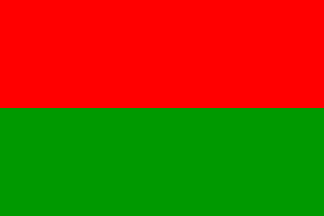 image by Ivan Sache, 25 September 2014
image by Ivan Sache, 25 September 2014
Liceo San Luis, located in Yarumal (Antioquia Department), originates in a
school established in 1899 by the notables of the town in the building housing
today Escuela Rosenda Torres. The establishment of a new school, to be named
Instituto San Ignacio de Loyola, was approved on 7 July 1905 by the Government
of Colombia. In 1910, Juan Arroyave, the parish priest, asked to the Superior of
the French Christian Brothers (Lasallian Brothers) to manage the school; Friars
Benoit Hildegrin, Emile Cervin, Daniel Paulino, and Joaquin Adolfa took the
direction of the school on 21 January 1911.
Following a dispute that had started in 1954 with the parish priest, Efraín
Jiménez Trujillo, regarding ownership of the school's building, the Lasallian
were ordered in 1963 by their Superior to withdraw from Yarumal. The school was
transferred to the Antioquia Department and renamed Liceo San Luis. In 1969, the
institute was open to girls and took over Instituto Pio XII. The institute is
named for St. Aloysius Gonzaga (1568-1591; canonized on 31 December 1726 by Pope
Benedict XIII), an aristocrat who studied with the Society of Jesus and died
during an epidemic of plague.
Source:
http://www.liceosanluis.8k.com - Institute's website
The flag of the institute is horizontally divided red-green.
Source:
http://www.liceosanluis.8k.com/nuestros_simbolos.htm - Institute's website
Photo:
http://www.liceosanluis.8k.com/cgi-bin/i/ceremonia.jpg
Ivan Sache, 25 September 2014
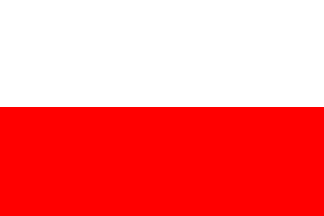 image by Ivan Sache, 04 August 2014
image by Ivan Sache, 04 August 2014
Liceo San Luís Beltrán is located in the village of San Luís, part of the
municipality of Sampuès (Sucre Department). The institute is named for St. Louis
Bertrand (1526-1581, canonized in 1671 by Pope Clement X), a Spanish Dominican
monk known as the "apostle of the Americas".
The flag of the institute is horizontally divided white-red.
Source:
http://www.iesanluisbeltran.edu.co/seccion.asp?idseccion=2&idsubseccion=7 -
Institute's website
Ivan Sache, 04 August 2014
"Colegio de San Luis Gonzaga " was founded on 1
October 1897 in Cali by the Marist Friar Adelber.
Marist friars, of French origin, settled in Popayán in 1889 and
in Cali in 1891, where they were confered the management of
"Colegio Santa Librada", originally founded in 1823 by
General Santander. The Congregation of the Marist Brothers was
founded in 1817 by St. Marcellin Champagnat (1789-1840).
The flag of the
institute, according to a photo and the description given on the website
of the institute, was designed in May 1945 by student Pablo
Marulanda, winner of the flag competition organized by the Center
for Social Sciences of the institute.
The flag is horizontally divided blue-white-yellow with the
emblem of the institute overall.
Blue represents the spiritual and Marian dimensions of the
studies.
White represents ethics and values.
Yellow represents commitment to work and effort for the
collective welfare.
The emblem represented on the flag does not seem to be strictly
equivalent of the current official emblem of the institute.
Ivan Sache, 15 January 2009
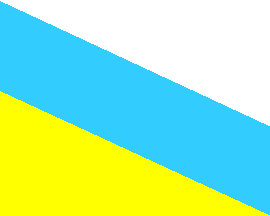 image by Ivan Sache, 08 July 2011
image by Ivan Sache, 08 July 2011
"Colegio San Luis Gonzaga" was founded on 8 February 1954 by the Society of
Jesus in Manizales (Caldas Department) and officially approved on 1 October
1954.
The flag of the institute, as shown graphically and described on the institute's
website, is diagonally divided (per bend) white-light blue-yellow.
White represents the eternal snows of Nevado del Ruiz [the volcano of 5,321 m in
elevation, located south-east of Manizales, whose eruption suppressed the town
of Armero in 1985, claiming 24,000 lives]. Blue represents the limpid sky over
the town. Yellow represents the wealth provided by coffee.
Source:
http://www.sanluisgonzaga.edu.co/sanluis.aspx?p=711
Ivan Sache, 08 July 2011
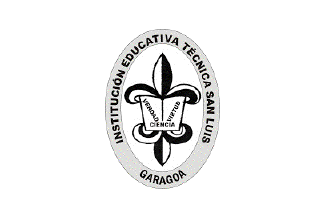 image by Ivan Sache, 17 November 2014
image by Ivan Sache, 17 November 2014
Institución Educativa Técnica San Luis is located in Garagoa (Boyacá
Department).
Liceo San Luis was established in 1948 by the Departmental Government. Colegio
San Luis and Escuela Normal Departamental Mixta Nuestra Señora del Rosario were
merged on 26 February 1975. Instituto Nacionalizado San Luis was established by
Resolution No. 1,848 of 30 July 2002 as the merger of Instituto Comercial
Nocturno Nacionalizado Jairo Calderón Salamanca and Instituto Nacionalizado San
Luis. Concentración Urbana Mixta Juan Nepomuceno Segura, established in 1989,
was incorporated into Instituto Nacionalizado San Luis by Resolution No. 2,381
of 30 September 2002.
The flag of the institute is white with the institute's emblem in the middle.
White is a symbol of light, purity, and of the virtues. The black and
white emblem expresses penitence, sacrifice and force. The white colour
protected by the black colour expresses that penitence preserves purity from any
hazard and evil.
The emblem of the institute is oval, charged with a fleur-de-lis, which means
the cultivation of values and is an emblem of nobleness and beauty. White is a
symbol of sanctity and science, while black represents force and sacrifice
required to obtain these values. The fleur-de-lis is superimposed with a book
inscribed with the institute's motto "VERDAD, VIRTUD Y CIENCIA" (Truth, Virtue
and
Science).
Source:
http://ietecnicasanluis.blogspot.fr/p/simbolos.html - Institute's blog
Ivan Sache, 17 November 2014
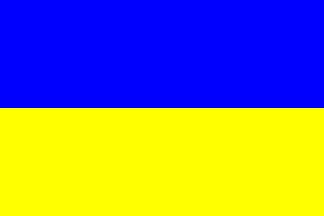 image by Ivan Sache, 9 January 2009
image by Ivan Sache, 9 January 2009
"Colegio San Luis Rey" was founded in 1957 in the
Franciscan Convent of San Francisco of Armenia, Department of
Caldas; the institute was inaugurated on 12 February 1957 in a
mass celebrated by Father Gustavo Estrada, Superior of the
convent, and first recognized by the Department of Caldas on 4
March 1957 (Decree No. 407). The institute moved to its today's
location in 1974.
The flag of the institute, as shown graphically and described on
the website
of the institute, is horizontally divided blue-yellow.
Blue represents heavens and highness while yellow represents the
sun and excellence.
Ivan Sache, 9 January 2009
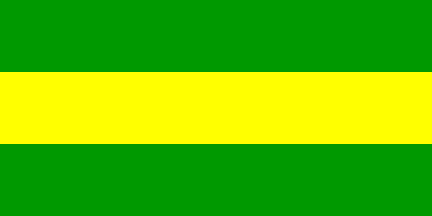 image by Ivan Sache, 29 September 2014
image by Ivan Sache, 29 September 2014
Institución Educativa San Martín de Tours (IESMAT) was established in San
Martín (César Department) in February 1974, as Colegio Cooperativo San Martín.
The institute is named for St. Martin of Tours (316-397).
The flag of IESMAT is horizontally divided green-yellow-green. Green is the
colour of the natural environment and hope. Yellow, the colour of the sun light,
represents joy, intelligence, and energy.
Source:
http://www.iesmat.edu.co/2012/12/bandera.html - Institute's website
Photos:
https://picasaweb.google.com/participademo/CAMPEONATOINTERCURSOS2010#5511724862674263282
https://picasaweb.google.com/participademo/JUEGOSINTERCURSOSIESMAT2012#5782873983012762994
https://picasaweb.google.com/participademo/JUEGOSINTERCURSOSIESMAT2012#5782874265834037426
Ivan Sache, 29 September 2014
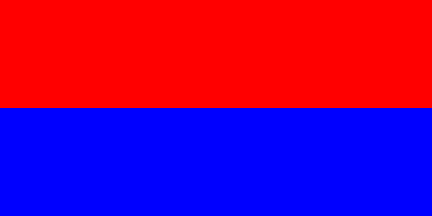 image by Ivan Sache, 11 January 2009
image by Ivan Sache, 11 January 2009
"Colegio Agustiniano de San Nicolás" is located in
Medellín.
The flag of the college, as graphically shown and described on
the website
of the institute, is horizontally divided red-blue. Red is
the symbol of a proud, chaste and valiant youth, also eager of
science and virtue. Blue is the symbol of the Augustinian mind,
oriented by infinite horizons.
Ivan Sache, 11 January 2009
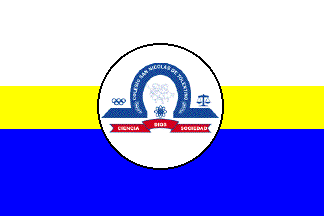 image by Ivan Sache,
5 July 2014
image by Ivan Sache,
5 July 2014
Colegio San Nicolás de Tolentino was established in 2002 in Suba (Bogotá) by
Javier Curtidor. The institute is named for St. Nicholas of Tolentino
(1245-1305; canonized on 5 June 1446 by Pope Eugene IV), the model of
discipleship.
The flag of the institute is horizontally divided
white-yellow-blue (2:1:2) with the institute's emblem in the middle. White is a
symbol of purity, peace, tranquility, transparency and beauty. Yellow is a
symbol of wealth - economic wealth cannot occur without academic and cognitive
wealth, felicity, of the sun and of the flowers generated by knowledge. Blue is
a symbol of the sky, of the air and of natural environment.
http://www.colegiosannico.edu.co/index.php/nuestro-colegio/bandera
Ivan Sache, 5 July 2014
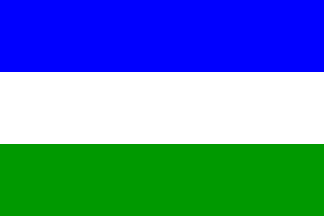 image by Ivan Sache, 08 August 2014
image by Ivan Sache, 08 August 2014
Gimnasio Bilingüe San Nicolás was established in 1999 in Neiva (Huila
Department)., as Colegio Infantil San Nicolás.
The flag of the institute is horizontally divided blue-white-green.
Source:
http://www.gimnasiosannicolas.edu.co/insignias-del-gimnasio-bilingue-san-nicolas/
- Institute's website
Ivan Sache, 08 August 2014
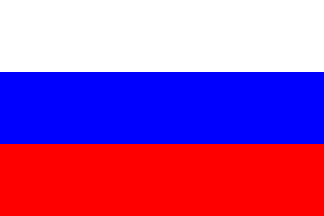 image by Ivan Sache, 09 July 2011
image by Ivan Sache, 09 July 2011
"Colegio San Pablo" was founded on 31 March 1989 by Emiliano de Jesus
Velásquez Rivera and Luis Alberto Escobar Bejarano in (Guadalajara de) Buga
(Valle Department).
The flag of the institute is shown graphically on the institute's website as
horizontally divided white-blue-red. White represents purity, science and
dignity. Blue represents the sky, fraternity and love. Red represents the blood
shed by Apostle St. Paul ("San Pablo") for the evangelization of the pagan
world.
Source:
http://colsanpablo.com/index.php?option=com_content&task=view&id=16&Itemid=31
Ivan Sache, 09 July 2011
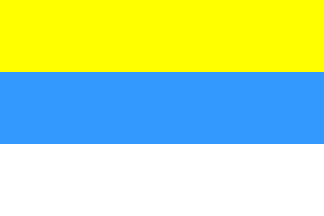 image by Ivan Sache and Peter Hans van den Muijzenberg, 12 September 2014
image by Ivan Sache and Peter Hans van den Muijzenberg, 12 September 2014
Liceo San Pablo was established in 1979 in San Pablo borough, part of the
municipality of Medellín (Antioquia Department), as a section of IDEM Santo
Domingo, eventually autonomous in 1982. Institución Educativa San Pablo was
established by Departmental Resolution No. 16,170 of 27 November 2002, as the
merger of Escuela Urbana Marco Fidel Suárez (est. in 1976 in Moscú No. 2 borough),
Escuela Urbana Medellín (est. in 1967 in Villa de Guadalupe borough), and Liceo
San Pablo.
The flag of the institute is horizontally divided yellow-blue-white. The three
stripes represents the three institutes merged to form Institución Educativa San
Pablo. The three colours represent the three levels of education supplied in the
institute:
- White represents the pre-school level, as a symbol of purity and beauty
required for the initiation of learning and knowledge;
- Blue represents the basic level, as a symbol of aspiration to learn, knowledge,
and path to wisdom and personal achievement;
- Yellow represents the median level, as a symbol of the light that irradiates
with knowledge and wisdom.
Source:
http://www.iesanpablo.edu.co/descargas/MANUAL%20DE%20CONVIVENCIA%20Y%20DE%20FUNCIONES.pdf
- Institute's Etiquette Guidebook
Ivan Sache, 12 September 2014
I know flag symbolism doesn't always make sense, but still: How does a school
supply a "pre-school" level of education. If it's a level they supply school at
it would seem to have become in-school instead.
Peter Hans van den Muijzenberg, 12 September 2014
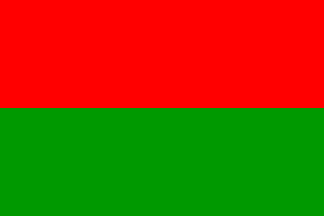 image by Ivan Sache, 03 July 2011
image by Ivan Sache, 03 July 2011
"Institución Educativa Téchnica San Pablo" (INETSAP) was founded on 28
November 2002 in Polonuevo (Atlántico Department) by Departmental
Decree No. 911, merging several institutes, including "Colegio de
Bachillerato San Pablo", originally founded on 1 December 1961.
The flag of INETSAP is presented on the institute's website as
horizontally divided red-green. Designed in 1968 by Baltazara Amador
de Domínguez, the flag uses the colors of St. Paul ("San Pablo")'s
clothes.
Source:
http://inetsaponline.blogspot.com/p/resena-historica-de-nuestra-institucion.html
Ivan Sache, 03 July 2011
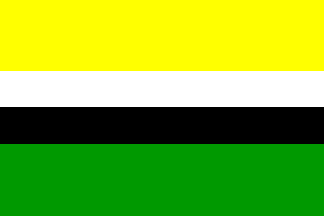 image by Ivan Sache, 04 August 2014
image by Ivan Sache, 04 August 2014
Liceo Psicopedagógico San Pablo (LPSP) was established on 10 February 1999 in
Bochica Sur borough (Bogotá) by Elizabeth Hernández, Bildad Hernández Márquez,
and Edith Cecilia Muñoz Nieto.
The flag of LPSP is horizontally divided yellow-white-black-green (2:1:1:2).
Yellow and green represent the spiritual resources. White and black represent
time and struggle.
Source:
http://liceosanpablo.edu.co/?page_id=100 - Institute's website
Ivan Sache, 04 August 2014




